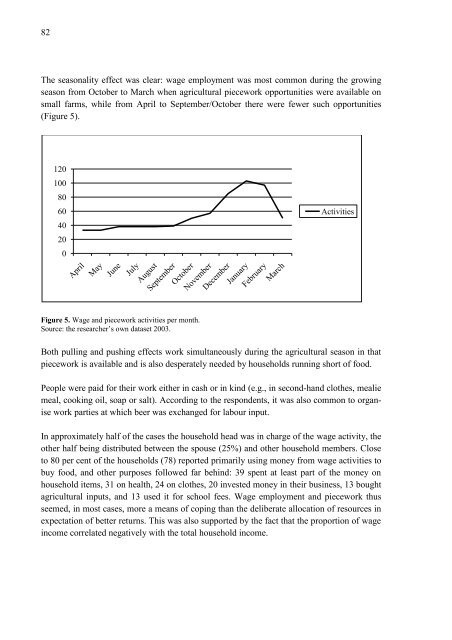Rural Income Generation and Diversification - A Case Study ... - Doria
Rural Income Generation and Diversification - A Case Study ... - Doria
Rural Income Generation and Diversification - A Case Study ... - Doria
You also want an ePaper? Increase the reach of your titles
YUMPU automatically turns print PDFs into web optimized ePapers that Google loves.
82<br />
The seasonality effect was clear: wage employment was most common during the growing<br />
season from October to March when agricultural piecework opportunities were available on<br />
small farms, while from April to September/October there were fewer such opportunities<br />
(Figure 5).<br />
120<br />
100<br />
80<br />
60<br />
40<br />
20<br />
0<br />
Figure 5. Wage <strong>and</strong> piecework activities per month.<br />
Source: the researcher’s own dataset 2003.<br />
Activities<br />
Both pulling <strong>and</strong> pushing effects work simultaneously during the agricultural season in that<br />
piecework is available <strong>and</strong> is also desperately needed by households running short of food.<br />
People were paid for their work either in cash or in kind (e.g., in second-h<strong>and</strong> clothes, mealie<br />
meal, cooking oil, soap or salt). According to the respondents, it was also common to organise<br />
work parties at which beer was exchanged for labour input.<br />
In approximately half of the cases the household head was in charge of the wage activity, the<br />
other half being distributed between the spouse (25%) <strong>and</strong> other household members. Close<br />
to 80 per cent of the households (78) reported primarily using money from wage activities to<br />
buy food, <strong>and</strong> other purposes followed far behind: 39 spent at least part of the money on<br />
household items, 31 on health, 24 on clothes, 20 invested money in their business, 13 bought<br />
agricultural inputs, <strong>and</strong> 13 used it for school fees. Wage employment <strong>and</strong> piecework thus<br />
seemed, in most cases, more a means of coping than the deliberate allocation of resources in<br />
expectation of better returns. This was also supported by the fact that the proportion of wage<br />
income correlated negatively with the total household income.

















